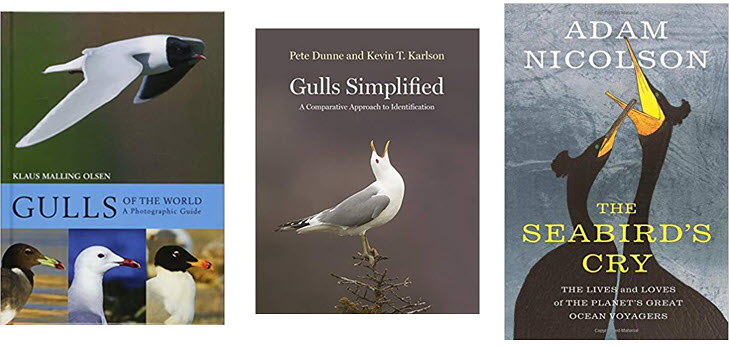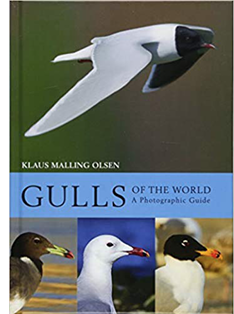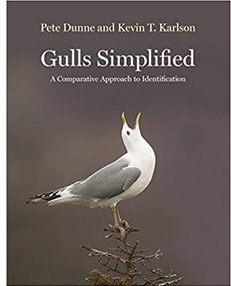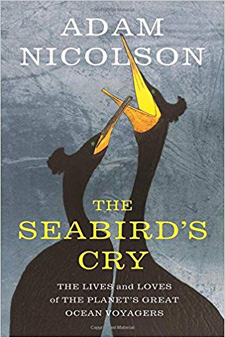Mark Lynch

Gulls of the World: A Photographic Guide. Klaus Malling Olsen. 2018. Princeton, New Jersey: Princeton University Press.
Gulls Simplified: A Comparative Approach to Identification. Pete Dunne and Kevin T. Karlson. 2019. Princeton, New Jersey: Princeton University Press.
The Seabird's Cry: The Lives and Loves of the Planet's Great Ocean Voyagers. Adam Nicolson. 2018. New York, New York: Henry Holt and Company.
That, instinctively and subliminally, is what these birds mean to us, voices from the interior of self and ocean, bringing to consciousness those unseen worlds, making apparent what would otherwise be hidden. (p. 5, The Seabird's Cry)
Seabirds hold a unique place in a birder's imagination and life lists. Some species, like the gulls and terns, can be seen near the coast or even well inland, but many species like the alcids or tubenoses need to be sought by going to the shore and looking out over the ocean. Here, scoping out over the rolling waves, views of the seabirds can be poor or fleeting. But the rewards are great too. Watching a shearwater effortlessly glide between huge wave troughs is to watch a creature at home in an environment distinctly hostile to us landlubber humans. In the hopes of seeing some of the more uncommon species, birders must venture out in ships onto the unpredictable oceans. You can be holding onto a ship's rail for dear life, trying to hold down breakfast, all the while buffeted by wind and spray, only to watch some tiny petrel flit by like it is no big thing to be out here in the elements. To add to the allure of seabirds, only a very few of us will ever see albatrosses, shearwaters, and petrels on their nesting territories because many seabirds breed on remote islands rarely visited by humans. Finally, as a group, sea birds can be very challenging to identify in the field. This is particularly true of gulls.
[T]he expression "you have to be madly in love to get into gull-watching" is very apt. (p. 9, Gulls of the World)
Gulls are the most consistently challenging group of birds to identify in the field. Many species look alarmingly alike even in adult breeding plumages and require close looks at small details to tell one species from another. Many species go through a series of dramatic plumage changes during the years from hatching to sexual maturity. This just further complicates field identification. If all that weren't enough, the taxonomy of some of the larger species is still being hotly debated, so that what in one guide may be called a species, in another guide may be designated as simply a subspecies. Just to make gull field identification even more daunting, hybrids between certain species are regularly seen.
What makes this galling is that gulls, more often than other species, will allow close views as they loaf about in large flocks on a pier or beach, just sitting there defying you to identify them. Uncommon migrants and vagrants from the west, Europe, and Asia do appear yearly here in New England, but it requires persistence and patience to pick these out from the numerous look-alikes perched nearby. Which is why, if you are like most birders, you already have several books dedicated to gull identification on your bookshelves. To further strain your bird book buying budget, here are two new gull identification guides that have recently been published.
 Gulls of the World by Klaus Malling Olsen is meant to be a comprehensive companion guide to his previous books on gulls. The identification details are thorough but concise and accompanied by several pages of color photography illustrating each species in various plumages. All species of gulls in the world and sub-species that can be determined in the field are described. Gulls of the World begins with short sections on subjects like how to age gulls; gull molt; how disease, oiling, and wear can affect a gull's appearance; gull hybrids; and tips on judging size and jizz. This portion of the book ends with a two-page topography of a gull. Gulls of the World then plunges into sixty-one species accounts, from Dolphin Gull to Red-legged Kittiwake.
Gulls of the World by Klaus Malling Olsen is meant to be a comprehensive companion guide to his previous books on gulls. The identification details are thorough but concise and accompanied by several pages of color photography illustrating each species in various plumages. All species of gulls in the world and sub-species that can be determined in the field are described. Gulls of the World begins with short sections on subjects like how to age gulls; gull molt; how disease, oiling, and wear can affect a gull's appearance; gull hybrids; and tips on judging size and jizz. This portion of the book ends with a two-page topography of a gull. Gulls of the World then plunges into sixty-one species accounts, from Dolphin Gull to Red-legged Kittiwake.
Each species account includes good range maps, descriptions of all plumages, voice, status, habitat, distribution, and a nice section on similar species. Several pages of high quality color photographs follow the written accounts.
It is interesting to see how Olsen treats those gulls whose species status has recently changed or is being debated. For instance, the Common Gull (Larus canus) is described as a "complex." Kamchatka Gull, whose scientific name Olsen lists as Larus (canus) kamtschatschensis, is described as a "distinct taxon within the Common Gull complex" (p. 85) and given its own section. Short-billed Gull (L. brachyrhynchus) is described as within the Mew Gull complex but given its own section too.
Iceland and Thayer's Gulls are treated as separate species, while Kumlien's Gull (L. glaucoides ‘kumlieni') is "treated as a hybrid swarm between Iceland and Thayer's Gulls on the basis of enormous individual variation, presenting all types of intergrades between the two species." (p. 173)
The list of Larus-type gulls that superficially resemble our Herring Gull has grown in the last half century to include species like Yellow-Legged, Azores, Armenian, Caspian, Steppe, Vega Gull and others. For a reader just casually glancing through this book, it may seem to be composed of unending detailed descriptions of minute differences in primary patterns and orbital color, but that is what it takes to separate these species in the field. Still, by the time I got to Olsen writing about the impossibility of determining a hybrid "Vega X Heuglin's Gull ssp. taimyrensis" (p. 253), I found myself longing for spring and warbler migration. You may find yourself admitting that you just don't have the obsessive-compulsive love of detail that it takes to become a real larophile. After a casual reading of Gulls of the World, you might find yourself asking if you are the kind of birder that discovers a Vega Gull in New England or are you going to be the birder standing in a group trying to pick out that Vega Gull that someone has already discovered and identified.
Gulls of the World is a solid reference book and an important contribution to the field identification of gull species, but I do have some minor criticisms. Frustratingly, species names do not head the photographic pages, so that you will find yourself flipping back till you reach the chapter title to know what gull you are looking at. This could be easily corrected in later printings. Surprisingly, there is no bibliography, though a short list of references ends each species account. This is not a field guide by any means. There is too much written detail to make it practical to use while you are in front of a flock of gulls. It's a book you might carry in your car but will more likely keep on the bookshelf at home until you return with a set of photos of some odd gull you might think is interesting. This is the book that will settle whether you have just seen a Mew Gull or a Common Gull.
 Gulls of the World is a tool, a fine but utilitarian book that, if one is honest, you don't really enjoy reading. Like an instruction manual, the writing is dry and to the point. By contrast, Pete Dunne and Kevin T. Karlson's Gulls Simplified is designed to keep a reader's attention and encourage you to learn those plumage differences. It is a gull identification guide with an attitude and a sense of humor. Who would have thought such a thing possible?
Gulls of the World is a tool, a fine but utilitarian book that, if one is honest, you don't really enjoy reading. Like an instruction manual, the writing is dry and to the point. By contrast, Pete Dunne and Kevin T. Karlson's Gulls Simplified is designed to keep a reader's attention and encourage you to learn those plumage differences. It is a gull identification guide with an attitude and a sense of humor. Who would have thought such a thing possible?
So daunting is this family that one accomplished field trip leader of my acquaintance, a person who can identify any North American warbler in three notes or less, categorically asserts: "I don't do gulls." (p. 14)
Well-known birder and writer Pete Dunne is just the sort to pull this off, despite the fact that he didn't even want to write this book.
This is a book that begged to be written, and for years I tried to get someone else to write it—a treatment of gulls that presents them in the simplified, straightforward way in which we regard bird groups, most notably raptors.(p. 16)
Also supporting my standing to write this book is that, while I am an experienced birder, I harbor no deep fascination with gulls. I accord gulls the same levels of interest I bestow on any other bird group. (p. 16)
So with the help of co-author Kevin T. Karlson, Dunne has written and designed an identification guide for the average birder who wants to hone their gull identification skills. One way was to reduce the number of gulls discussed in the guide. Gulls Simplified mostly considers only those species that breed in North America. Species accounts are grouped into three general categories based on the way they appear to birders, not taxonomy. There are "Small to medium-sized gulls and hooded gulls," "Gray-backed white-headed gulls," and finally "Large dark-backed gulls." A final group of "Dark horse gulls" is dedicated to those species that are rarely seen in the Lower 48 states like Ivory and Ross's gulls as well as a few extralimital species that have shown up in the Lower 48 like Slaty-backed and Kelp gulls.
Where Dunne and Karlson draw the line with regard to some taxonomically-challenged species is interesting to contrast with Olsen's Gulls of the World: "The implications of all your present field guides notwithstanding, there is no such species as Thayer's Gull anymore." (p. 126)
Each species account begins with a short one or two sentence description by Dunne (more on those later) and then includes a long "Profile" that contains a lot of information on jizz and behavior. This section excels at giving the birder a general sense of how this species of gull will appear in contrast to other species. An example in that section under Ring-billed Gull: "Longish legs and quick, mincing steps differ from Herring Gull's waddle-and-stride style of walking." (p. 104)
This is followed by a paragraph, with a color map, on status and distribution. Finally there is a longer section on details of adult and immature plumages. The numerous high-quality photographs are printed with the text, and the species name is found at the top of every right hand page, so you do not have to flip back to see what species you are looking at.
The text is clear and focuses on the essential identification points, contrasting those with similar species. Different species are often shown in the same photograph to show differences in behavior, shape, size, or plumage. Gulls Simplified ends with a seven page "Quiz and Review" section which has a large number of photos that the reader has to identify. The answers are discussed in detail at the end. This is a fun section and birders of any skill level will enjoy seeing how they fare.
As I mentioned above, for each species, Dunne has penned a one or two sentence introduction. These set the tone for the book. They are often funny, sometimes odd, and usually very apt. For Herring Gull: "It's the large, silver gray-backed gull with the six-pack holder around its neck, a testimony to its slim head and a token of its proclivities for landfill trolling and Dumpster diving." (p. 86)
Or under California Gull: "It's a Herring Gull drawn by El Greco with a Mormon cricket in its mouth." (p.96) This description will likely have a number of birders Googling the works of El Greco. For some reason, many of these pithy descriptions focus on food items in the gull's mouth and include items like sewage pipe unmentionables, a sesame seed bun, a boardwalk hot dog, a ham sandwich, corn dogs, tilapia, and, most cryptically, under Black-tailed Gull: "… with nothing in its bill because you aren't really seeing it." (p. 181)
Are these descriptions crucial? Of course not, but they do invite the reader to have fun looking at gulls, and that is a worthwhile goal.
Gulls Simplified benefits from having an author who has written a number of books on raptor identification over the decades, knows how to keep readers engaged, and encourages them to have fun with identification challenges. Dunne also knows that there are things to look for in determining a field identification other than minute details of plumage alone. I think Gulls Simplified is a more enjoyable book because it is from an author who only reluctantly wrote this guide and who, by trial and error in the field, knew what he would like to see in a book about identifying gulls.
Each displays a different facet of the central question: how to exist in all three elements. They are the rarest form of creation, the only animals at home on the sea, in the sea, in the air and on land. (p. 7-8, The Seabird's Cry)
 Though the previous two books will help you tell what you are looking at, The Seabird's Cry by writer Adam Nicolson explores why we find sea birds so fascinating. Nicolson is not a scientific seabird expert. He is an award-winning writer who has authored books on subjects like the Greek poet Homer. But he has had a lifelong passion for all seabirds. This began when he was a child and his father inherited one of the Shiant Isles, a small island group off the Hebrides. His family would periodically vacation on this rugged wind-blown isle where there was a small cottage with no electricity or other amenities. What there was on the Shiant Isles were thousands of nesting seabirds: fulmars, kittiwakes, gulls, cormorants. This experience of living among the nesting seabirds so affected Nicolson that for much of his adult life he has sought out seabirds of every kind where they nest and live, traveling around the world in search of seabirds. The Seabird's Cry is Nicolson's attempt to put into words why he and so many of us have a passion for these birds. In each chapter Nicolson looks at one of ten different species, pairs, or groups of seabirds: fulmars, puffins, kittiwakes, gulls, guillemots (what we call murres), cormorants and shags, shearwaters, gannets, Great Auk and its cousin Razorbill, and finally albatrosses. Though each chapter discusses at length numerous scientific studies, Nicolson is just as interested in the history of human interaction with seabirds.
Though the previous two books will help you tell what you are looking at, The Seabird's Cry by writer Adam Nicolson explores why we find sea birds so fascinating. Nicolson is not a scientific seabird expert. He is an award-winning writer who has authored books on subjects like the Greek poet Homer. But he has had a lifelong passion for all seabirds. This began when he was a child and his father inherited one of the Shiant Isles, a small island group off the Hebrides. His family would periodically vacation on this rugged wind-blown isle where there was a small cottage with no electricity or other amenities. What there was on the Shiant Isles were thousands of nesting seabirds: fulmars, kittiwakes, gulls, cormorants. This experience of living among the nesting seabirds so affected Nicolson that for much of his adult life he has sought out seabirds of every kind where they nest and live, traveling around the world in search of seabirds. The Seabird's Cry is Nicolson's attempt to put into words why he and so many of us have a passion for these birds. In each chapter Nicolson looks at one of ten different species, pairs, or groups of seabirds: fulmars, puffins, kittiwakes, gulls, guillemots (what we call murres), cormorants and shags, shearwaters, gannets, Great Auk and its cousin Razorbill, and finally albatrosses. Though each chapter discusses at length numerous scientific studies, Nicolson is just as interested in the history of human interaction with seabirds.
A central concept that unites all the chapters is the concept of umwelt. This term was originated by late 19th and early 20th century German biologist Jakob von Uexküll. Nicolson crowns him "the Prospero and hidden mage of all modern seabird studies." (p. 17) Unwelt loosely translated means "surrounding world," and what von Uexküll was trying to convey with it was each creature's unique subjective view of the world based on how they sensed their environment. For example, in The Seabird's Cry, we read that many tubenoses, including the Sooty Shearwater, navigate across hundreds of miles of featureless oceans using a superb sense of smell. For the Sooty Shearwater, their mental map of their world is partially made up of olfactory cues, something we can only imagine.
The history of human cultures' interest and passion for seabirds has ranged from the poetic to the utilitarian to profligate wasting. Nicolson often quotes literature and poetry to investigate these human relationships with seabirds. He spends some time trying to identify the albatrosses' species in works by authors like Coleridge and Melville.
On the utilitarian side, the historic human population of the island of St. Kilda in the Outer Hebrides centered their lives around the nesting of the fulmars and other seabirds:
The St Kildans, with little meat and next to no fish, ate the birds, above all the fulmar, of which they consumed more than 100 each year, plus young gannets, the puffins and mountains of eggs. The prominence of seabirds in St. Kilda life meant that from the seventeenth century onwards visitors recorded the seabird-human relationship in great detail. (p. 41)
Every part of these seabirds were important:
The 12,000 oily chicks, handsomely provided for by their ocean-traveling parents, gave the St Kildans each year about 600 gallons of oil. Fulmar feathers were also collected and, more valuable than puffin or gannet feathers, they paid most of the rent up until about 1902. In 1847, each family had to give the landlord 7 St. Kilda stone (1,176 pounds) of feathers, most but not all from fulmars. Feathers from eighty fulmars were needed to make a single stone. (p. 45)
As humans explored the furthest parts of the world's seas, their use and abuse of seabirds increased. Kittiwakes were plundered by the thousands on their nesting cliffs for the international trade in feathers for women's hats. But those predations were just the beginning. It became in vogue for Victorian sportsmen to take a boat and sail by kittiwake nesting cliffs and just blast away, killing as many as they could, something called "shooting flying." (p. 91)
Though you may think you have read these tales of human carnage on seabirds before, Nicolson often brings in some new twist on the story. In the chapter on the Great Auk, Nicholson looks at the Victorians' strange fascination with this alcid that was already extinct by their time. The Victorians "made a fetish of absence" (p. 285) and furthermore sought "to keep loss palpable, not to be consoled but to feel the death—annihilation—as inspiration" (p. 285). The auk's extinction gave poignant meaning to a culture seeing the environmental destruction caused by the Industrial Revolution.
By the time we get to the later 20th century and afterwards, the impact of human society on seabird's lives has become greater still, but for different, more insidious, reasons. Dimethyl sulfide is a chemical that some seabirds can smell at great distances. It is given off by krill eating phytoplankton and is therefore a flag for seabirds which are searching for food in those areas. But it has now been discovered that some plastics after being in saltwater for a period of time also give off plumes of dimethyl sulfide, thus attracting seabirds to gulp the plastics down. Here the plastic inert refuse remains in the seabird's gut until it slowly kills the bird. We have dumped so much plastic into the world's oceans that almost all seabirds examined postmortem now have some plastics in their digestive systems. Ultimately there is global climate change, the coup de grâce for most seabirds for reasons too numerous to list here but well described in The Seabird's Cry. "Over the last sixty years, the world population of seabirds has dropped by over two-thirds. One-third of all seabird species is now threatened with extinction." (p. 336)
Thanks to the quality of Nicolson's writing, The Seabird's Cry is a book to be savored and enjoyed. It describes humanity's millennia-long love for and fascination with these birds that appear so at home on land, air, and sea. You cannot but be in total awe of an albatross that over the course of its lifetime may have flown "more than 5 million miles" (p. 324) over towering raging seas and through wild winds. Ultimately this book is a call to arms about our treatment of these amazing birds, their oceans, and the entire planet.